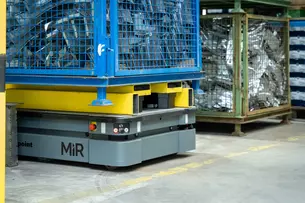Autonomous mobile robots are indispensable for modern intralogistics. Driverless transport systems, which largely control themselves and consequently the material flow as well, also play an indispensable role in the vision of autonomous production. The vehicles can be used for efficient and flexible production steps, cargo transport, storage and picking processes. But what needs to be considered for proper integration into production and when is such a system really autonomous? Here are the five most important questions that should be clarified in advance:
“Ask yourself: Why do I need a DTS in my production? The reason for using a driverless transport system should never be an end in itself,” Michael Jürgens explained, Head of AGV Solutions at Kuka. "Otherwise, this can backfire quite quickly, which usually causes setbacks in technology and processes at the operating company.” Companies should always set themselves the goal of relieving the burden on people when considering where a DTS could be used, Marco Unverzagt stated, Managing Director at the system integrator Hahn Robotics: “It must be made clear to the worker during implementation that the driverless transport system is not to replace people, but will only perform simple and monotonous tasks such as transports from A to B.” In this way, people can concentrate on more important tasks that a robot cannot perform. Other questions users should consider are: Do I have concrete cost advantages due to the driverless transport system? Can I increase utilization of my process equipment thanks to more efficient processes? Does it increase my flexibility?
And: What effects does it have on my system utilization? Mr. Jürgens advises companies to always start a pilot application first and consult a system integrator for planning after considering all questions.

“Safety is crucial for the integration of mobile robots, because it is the prerequisite for their comprehensive freedom of movement,” Thomas Visti said, CEO of Mobile Industrial Robots. One question has to be asked according to Michael Jürgens: “Against the background of personal safety, are my environmental conditions even suitable for the integration of a driverless transport system?” This should be checked at the very beginning with a system integrator, since there would have to be prerequisites that could not be ignored. An example: If the space requirement is not sufficient – for example in a transfer station or at narrow crossings and passing points – and it is determined too late, the entire plant often has to be rebuilt. Thomas Visti pointed out how safe DTS solutions are today: “Equipped with powerful sensors and modern security algorithms, our MiR robots are able to detect people, objects and other driverless transport systems in good time. Depending on the situation, they will either avoid them or stop. In many cases, they are already replacing forklifts, which are often involved in accidents."

Michael Jürgens, Kuka: “WLAN with sufficient coverage is usually sufficient for communication. However, those who prefer a homogeneous network structure can also benefit from 5G. We don’t have any bottlenecks yet with the data volume that we transfer with DTS, but instead with the computing capacity for planning algorithms,” the DTS expert explained.
In particular, AMR (Autonomous Mobile Robot) systems, whose autonomy is highly pronounced, are considered to be very user-friendly. Marco Unverzagt explained the difference to the conventional AGV (Autonomous Guided Vehicle), which in comparison to this has to be programmed at great cost: “An AGV requires tracks, i.e., magnetic strips or cables that guide the vehicle past possible obstacles. The lack of flexibility and the associated costs can be a problem when a work area has to be changed and the track has to be adapted accordingly.” In contrast, an AMR behaves much more intelligently, because it is not tied to a track, but instead makes its own way. As a result, the working range of the AMR can be expanded or changed more easily.
In the case of autonomous transport robots, the use of fleets also makes sense to make the processing of internal logistics processes scalable, Thomas Visti from Mobile Industrial Robots stated – all the way to ERP connection and swarm intelligence. The role of AI and machine learning will play an increasingly important role here in the future. Therefore, the integration of AI technologies makes route finding and navigation even more efficient, since they allow robots to share sensor input and learn on this basis. For example, highly frequented areas could be avoided in advance by the autonomous driverless transport systems.

Users should pay attention to intuitive usability when selecting autonomous transport solutions, Thomas Visti advises. It helps employees to get their bearing with the new automation solution faster while saving time for cost-intensive training. In addition, the easy handling of a DTS system increases its acceptance on the employee side.
One thing is clear: The more easily an application can be integrated into the ongoing processes, the faster it can actively support them and recover acquisition costs. This in turn makes the investment affordable even for small and medium-sized enterprises. Thomas Visti explained: “Our Mir robots can be integrated into a WLAN or ERP system, for example, and are ready for use just a few hours after delivery.” Marco Unverzagt from Hahn Robotics confirmed this plug-and-play approach: “The concept of a superuser is pursued on the customer's side, that is, the customer is trained on the devices and can carry out all the necessary work independently without having to rely on the integrator and its personnel.”

Thomas Visti knows: “A transport robot without an attachment is like a smartphone without apps – it doesn't add any value. Different attachment modules enable a wide range of applications and allow the same robot to be used for a wide range of activities.” The Robotics CEO therefore concluded by recommending: “When choosing a solution, users should be careful to ensure high compatibility with different modules.”